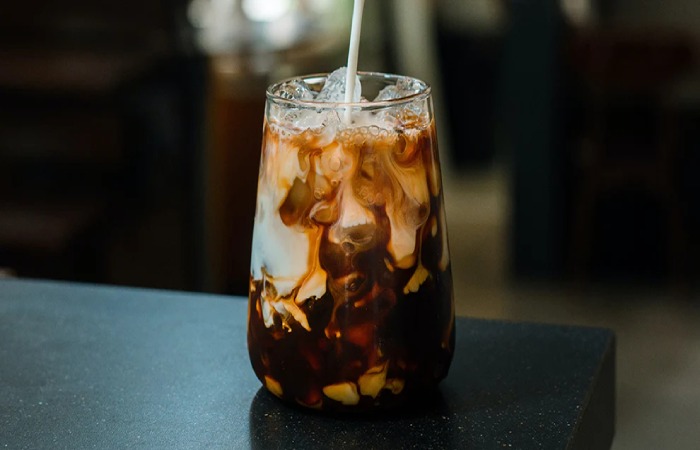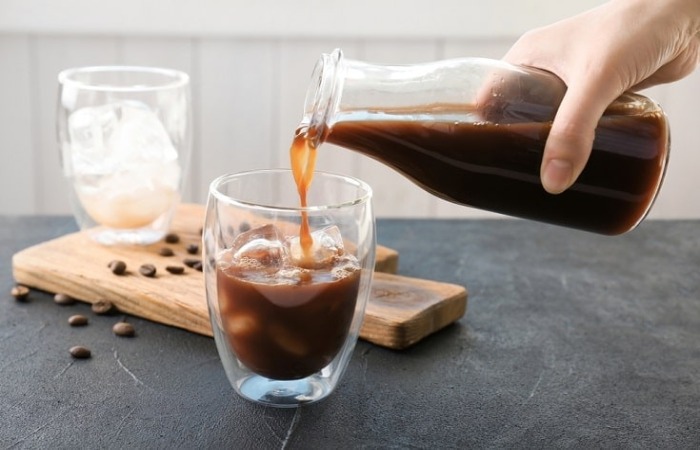Table of Contents
Introduction
How to filter cold brew coffee – Cold brew coffee is unique and involves soaking coarsely ground coffee beans in room temp water for an extended period, usually 12 to 24 hours. This brewing technique extracts the full-bodied flavors from the coffee beans without the bitterness and acidity commonly associated with hot brewing methods. The end product is a smooth, concentrated coffee that can be diluted with milk or water and served over ice for a refreshing and invigorating beverage.
Benefits of Cold Brew Coffee

For coffee enthusiasts, cold brew coffee is preferred due to its numerous advantages.
Lower Acidity
Cold brew coffee generally has a lesser acidity level than hot-brewed coffee. Making it easy on the stomach and a preferable option for those with acid reflux or sensitive stomachs.
Smoother Taste
The cold brewing process extracts less bitter compounds from the coffee beans, follow-on by a smoother, less astringent taste that many people find more enjoyable.
Higher Caffeine Content
Cold brew coffee typically has a higher concentration of caffeine than traditionally brewed coffee due to its extended steeping period and higher coffee-to-water ratio. It makes it a popular choice for those seeking an extra energy boost.
Longer Shelf Life
One of the benefits of cold brew coffee is that its concentrate can be refrigerated for up to two weeks without losing its rich flavor. It makes it an ideal option for people who prefer to prepare their coffee in advance and enjoy it at their convenience.
Cold Brewing Process
The process of making cold brew coffee is relatively simple. Still, it does require little patience and experimentation to find the perfect balance of water-to-coffee ratio, brewing time, and filtering methods.
The main steps in the cold brewing process are as follows:
Coarsely Grind Coffee Beans
Using a coarse grind will ensure proper extraction and reduce the chance of over-extraction, which can lead to bitter flavors.
Combine Coffee Grounds and Water
Mix the ground coffee with cool or room-temperature water in a container. Stir thoroughly to ensure all of the coffee grounds are soaked.
Steep for 12-24 Hours
Allow the coffee mixture to steep for an extended period, either in the refrigerator or at room temperature. Steeping duration can affect the strength and flavor of the cold brew, so experimenting with brewing times is encouraged.
Filter the Coffee
Strain the coffee mixture through a filter to separate the grounds from the liquid. Various filtering methods, such as a French press, cheesecloth, or coffee filter paper, can be used.
Store and Serve
Store the cold brew essence in the refrigerator and dilute it with water or milk as desired before serving over ice.
With this understanding of cold brew coffee basics, one can explore different recipes, techniques, and equipment to find the perfect cold brew that suits their taste preferences and lifestyle.
Preparing Cold Brew Coffee

Making the perfect cold brew coffee involves a combination of factors, such as selecting the proper coffee grounds, determining the coffee-to-water ratio, and considering the steeping time and temperature.
Selecting the Right Coffee Grounds
Choose a coarse grind for cold brewing to prevent over-extraction and bitterness. Coarsely ground coffee allows water to flow through the grounds more efficiently, promoting even extraction and better flavor. To achieve the ideal texture, grind your coffee beans before brewing or purchase coarsely pre-ground coffee.
Coffee-to-Water Ratio
The coffee-to-water ratio is a vital aspect of cold brewing, as it influences the strength and flavor of the final product. A standard recommendation is to use a 1:4 or 1:5 coffee-to-water ratio. For example, you could use 1 cup of coarsely ground coffee for every 4 or 5 cups of cold, filtered water. Adjust this ratio affording to your taste preferences and desired coffee strength.
Steeping Time and Temperature
Proper steeping time and temperature are essential for extracting the best flavor from your cold brew coffee. Generally, cold brew coffee is steeped for an extended period to ensure optimal extraction of the coffee’s flavor compounds.
The ideal steeping time for cold brew ranges from 12 to 24 hours. Shorter steeping times may lead to a weaker mixture, while steeping beyond 24 hours may over-extract and result in bitterness. Experiment to find the perfect steeping duration for your taste preferences.
As for temperature, cold brew coffee can be steeped at room temperature or in the refrigerator. Steeping at room temperature typically results in a bolder and more robust flavor, while soaking in the fridge often produces a milder, smoother taste. Choose the temperature based on the flavor profile you desire.
Once you’ve considered these factors, use a cold brew coffee maker to simplify the brewing process and ensure optimal results. Combining your chosen coffee grounds, the appropriate coffee-to-water ratio, and attention to steeping time and temperature will yield delicious cold brew coffee every time.
Why Filter Cold Brew Coffee
Filtering cold brew coffee is essential to remove the coffee grounds and any suspended particles that may have dissolved in the brewing process. Proper filtration ensures a clean, crisp taste without unwanted sediment or bitterness. Moreover, it is necessary to prevent the over-extraction of flavors or an undesirable texture in your beverage.
Types of Filters
There are several filter options when filtering your cold brew coffee concentrate. Some commonly used filters include:
- Paper filters: Paper filters are disposable and can be used once. They effectively capture fine particles and reduce the amount of sediment passed through.
- Cheesecloth: Cheesecloth is a reusable cotton fabric used traditionally to strain liquids. When using cheesecloth, it is essential to ensure that it is clean and thoroughly rinsed before use.
- Fine mesh strainers: Fine mesh strainers or sieves can be used independently or in combination with a paper filter or cheesecloth to improve the filtration process.
- French Press: A French press is a prevalent way to brew and filter cold-brew coffee. The metal plunger and mesh filter assembly separate the coffee grounds from the liquid, providing effective filtration.
- Cold brew coffee filter bags: Designed specifically for cold brew coffee, these bags are made from delicate mesh material and can be filled with coarse ground coffee, making the filtration process more straightforward and less messy.
Filtering Techniques
There are various techniques to filter cold brew coffee, each providing a different level of filtration and flow rate. Some popular methods include:
- Gravity Filtration: Pour the cold brew concentrate through a paper filter, cheesecloth, or fine mesh strainer set over a container or mason jar. Allow the liquid to pass through the filter by gravity, leaving the grounds behind.
- French Press Filtration: If you used a French press to brew your cold brew coffee, push down the plunger to separate the grounds from the liquid. Pour the filtered coffee into a container or glass to enjoy.
- Filter Bag Method: When using a cold brew coffee filter bag, lift the bag filled with grounds out of the brewing container, allowing the liquid to drain through the mesh material of the bag.
Conclusion
In conclusion, filtering cold brew coffee is essential in achieving a smooth, rich, and flavorful beverage. By choosing the proper filtration method and following a few essential tips, one can ensure a satisfying cold brew experience.
As discussed, several techniques are available for filtering cold brew coffee. Such as using a cheesecloth, fine mesh filter, French press, or a two-step filtration process to remove coffee grounds thoroughly. Each method may suit different preferences and equipment available at hand.
